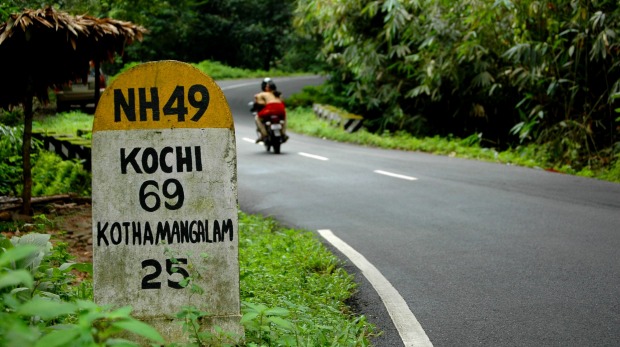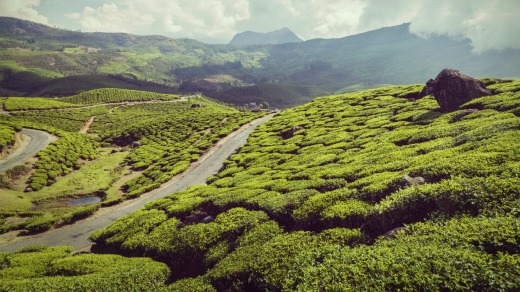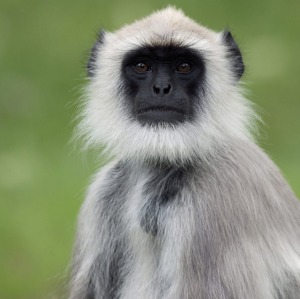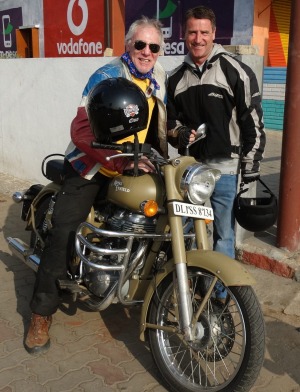
Before leaving home to ride a famous Royal Enfield Classic 500 motorbike through southern India my biggest worry is that a water buffalo will jack-knife in front of me – but the closest call comes at the hands of a chicken.
We have just negotiated many kilometres of winding, disastrously potholed roads down the mountainside below the hill station town of Munnar, 1600 metres above sea level, when on a relatively straight stretch a white blur launches itself at my helmet.
Ian Chapman, a fellow rider from Brisbane, is right behind when the "attack" happens. "What did you do to that chook?" he laughs when we stop a few kilometres further on. "It took a running jump and launched itself. Had a real red hot go, too."

The chook misses by centimetres but it is fair warning – everything here is trying to kill you. It's mostly passive-aggressive stuff, though – the chook is very much the exception.
And yet we – seven experienced motorbike riders – survive the trip virtually intact and with huge, wow-did-we-really-do-that grins.
Look, death is waiting out there ... remember, the horn is your friend; it is everything.
Vince Kierans
On our last day, after we drop off the motorbikes in the little seaside hamlet of Chapora in north Goa, Extreme Bike Tours owner Alexander (Zander) Combe, takes the group out for lunch at La Plage, a laid-back French restaurant on the beach.

There, over fresh grilled fish, excellent mojitos and Kingfisher beers, we talk about our adventures, reminiscing about the trials and tribulations, the laughs and the highs and the bum-numbing, back-breaking lows. "Well," says Combe with a grin, "there's a reason we didn't call it Soft Old Farts Biking."
Combe, an amiable 40-year-old Englishman who has lived in Goa for 21 years, started Extreme Bike Tours six years ago with his Indian friend Vijay Shirodkar – who drove the back-up vehicle on our trip and kept the bikes running.
They started with three bikes in 2006 and now have 48, running 18 tours a year throughout Indian, the Himalayas, Tibet, Mongolia and Bhutan – with Cuba (on a Harley) on the cards in the near future.

Our Boys' Own five-star adventure starts in Kochi (Cochin), a port city of 600,000 people in the state of Kerala (motto: God's Own Country), and a short introduction to the Enfields in the car park of Le Meridien Hotel.
It could just as easily be a Girls' Own; 20 per cent of customers last year were women and 80 per cent of those were riders rather than pillion passengers.
As regular bikers, it doesn't take us long to get used to these doughty army-green machines – after all, it's electric ignition, five gears, one down, four up, and away you go. Of course, the mechanics are one thing but it's the heritage of these beasts that has brought us here. Our group, after all, isn't really here for India – we're here for the chance to put an iconic motorbike through its paces.
Royal Enfields are the British/Indian equivalent of America's Harley Davidson – distinctive bikes with a great history and such authenticity they could never be mistaken for anything else.
The company started out making parts for the British army in 1891- hence its gun logo and "Made Like a Gun, Goes Like a Bullet" motto – and made its first motorbike in 1893. The British company folded in 1971 but Enfield of India, which had been assembling bikes under licence since 1956, just kept going.
Royal Enfield India is still knocking out motorbikes today, making it the oldest motorcycle brand in the world in continuous production. So you're not just riding a motorbike, you're riding history.
I like it immediately for its lack of bells and whistles and an upright riding position that doesn't put stress on wrists or neck; it's simple, feisty and tough with plenty of power even in second gear. And while it's not going to win any beauty competitions it is just so damn cool- looking. The brakes work well, too – trust me, this is important in India.
The next day we set out early to avoid the worst of the traffic. It's a Sunday, too, which should help but only makes me suspect that the Monday morning rush hour must be hell on wheels.
The secret to survival, we discover from the insistent tutelage of tour leader Vince Kierans, is the horn and the constant use of it. Neil Chapman, an electrical engineer from Port Macquarie and one of three Chapman brothers on the journey, speaks for most of us when he says he's hard-pushed to find the horn on the few occasions he has had to use it in Australia.
Here, on the other hand, it's the difference between life and death and within minutes of starting off we're all blasting away at anything that moves or looks like it might possibly perhaps move in the mayhem masquerading as Indian roads. Buses, tuk-tuks, scooters, cyclists, pedestrians, trucks, dogs, goats, cows, oxen, monkeys, each other – they all get a serve.
At first, it seems terribly rude but very soon you realise that if there are any actual road rules in India – certainly the few speed limit signs seem to be mere suggestions – it's that the horn is used to great effect. It says "I'm here", "look out", "coming through", "get out of the way" and "if you don't let me cut in I'm going to end up splashed across the front of this oncoming bus".
On our first day Kierans warns: "Look, death is waiting out there ... remember, the horn is your friend; it is everything."
The basic rules are these: your indicators are pretty much useless; use the horn constantly; flash headlights when overtaking; hug the inside of the lane except when overtaking as everyone coming the other way will be overtaking, too. And some of the "overtakers" will also be being overtaken.
It is not unusual, on our journey, to watch a truck overtake a truck that's overtaking a car. On a blind hairpin bend. And for one or more of us to find space to overtake that. We become expert at praying to God of the Gaps, changing down and shooting through spaces we would never dream of attempting in Australia.
It's crazy, frustrating, heart-pumping, eye-opening, dusty, dirty, diesel-belching, bum-clenching fun.
Lloyd Hitchins, a palliative care community nurse from the Blue Mountains who also happens to be the Chapman brothers' cousin, hits the nail on the head when he says: "We might get one of these near-misses in 10 years in Australia – here we get 400 in one day."
The bikes themselves are hardy, single-cylinder beasts with plenty of power to get you out of trouble when you fluff a gear change on a sharp bend and find yourself chug-chug-chugging up a steep incline in third.
Peter Green, a long-time friend of the Chapmans from Dubbo, says: "I've owned a lot of bikes but I'm amazed by these – they just take everything you throw at them."
Well, almost; on day two an extraordinarily large pothole puts one of the bikes out of action for a few hours after some underarm-overhang thingy snaps in two. This is where Vijay and his assistant, Raoul, come in handy. They, after all, know what it is that's broken, don't have to resort to calling it the underarm-overhang thingy and eventually fix it at a roadside chai stop.
Another thing we learn to look out for are the ninja speed bumps. India is awash with them, they're often not marked and can come as a surprise when they leap out at you at 80km/h. Then there are the double, triple and quintuple versions, which can shake the fillings out of your teeth.
One of the Chapman brothers suggests that taking all the bitumen out of the speed bumps and using it to fill the potholes might be an improvement but on the whole the standard of the roads we use is pretty good.
And while the roads in the cities and towns and villages can seem like bedlam, there is method in the madness that makes me feel safer here than at home. After all, India is a nation steaming headlong into the future on two wheels – and the other road users respect that.
Some days are too long – eight or more hours in the saddle is back-breaking - but the lack of five-star hotel accommodation in the areas we pass through means it can't be helped. Though there is fun to be had in watching seven grown men twisting and turning and stretching and even standing on their bike's pegs to relieve the pressure on their nether regions. And all at 90km/h.
But, to my mind, it's worth every minute of the discomforts for the highs of an open road where you can let rip or throwing your bike left and right around the bends that sweep grandly through luminous green tea plantations shaped like underwater coral, or pausing to admire mountainous vistas peppered with vertiginous corniches.
In 10 days and more than 2000 kilometres we pass through the heat and dust of crowded cities, rural hamlets and towns on market days bursting with people and wandering farm animals. "This place goes from chaos to countryside in minutes," reckons Green.
We trundle through English-style tea plantation towns in the highlands, along beautifully smooth and wide bitumen "highways" and around sandy back roads peppered with palms and grand, white Catholic churches, garish Hindu shrines and Portuguese-style houses painted in eye-searing pinks and blue and purples, like giant frosted wedding cakes.
We speed into the Bandipur tiger reserve with minutes to spare – they close the gates at 7pm – and finish the punishing 11-hour trip (it was the day of the breakdown, a sprocket malfunction and a slow, gear-assisted descent down a mountainside with 36 hairpin bends) under the glow of a blood-orange setting sun. Here, we don't see any tigers but we do see elephants, hanuman monkeys in bright Indian coral trees and fighting peacocks.
We stop to visit crumbling palaces and ancient temples at the top of precipitous hills and we learn to appreciate the joys of a good thali plate. There are scenes of utter desiccation, craggy mountain passes, fecund jungle, shaded forests, rice fields spiked with egrets and long stretches of red earth dotted with gum trees which bring to mind outback Australia.
There were close calls and too-close calls – you really have to have your wits about you - and one unavoidable accident which left 53-year-old Ian Chapman with a hairline fracture in his foot after a boy racer pulled across the road without looking. After an X-ray, he was bravely (stubbornly, according to his older brother Ross) back on the bike the next day – albeit still needing crutches to walk.
I, too, had my own little solo bingle, about which the less said the better. Suffice to say, the back brake's there for a reason.
Our tour leader, Kierans, came to Goa from Coventry for a 10-day holiday 20 years ago and stayed. He summed it up beautifully when he said: "I love India. It's why I've been here so long, man. It's like an amusement park ride, but without the seat belts."
The writer was a guest of Extreme Bike Tours and AirAsia.
1. Use your horn constantly. If you don't use your horn you don't exist. It is surprisingly efficacious. You very quickly get annoyed with people who don't use their horn and appear at your elbow unannounced.
2. Flash your lights when overtaking. Everyone coming the other way will do the same but at least you know where everyone is. It essentially says "'m coming through, big boy, get out of the way".
3. Size rules. If that huge truck/bus driven by the bug-eyed, quite often drugged-up, driver wants to pass, let it. This is especially true of buses, which seem to operate with their own set of rules. Never assume just because it's indicating that it's actually going to stop to pick up those passengers.
4. Assume everything is just dying to throw itself under your wheels. This includes other motorised vehicles, carts, cows, oxen, monkeys, chickens and potholes. Looking out to see if anything's coming doesn't seem to be a priority here.
5. Keep a sharp eye out for speed bumps; they are everywhere and, very often, disguised as the road. They appear without warning or provocation. We took to riding off the road and going around them though this isn't always possible.
1. Route 66 on a Harley Davidson with Eaglerider. Follow the original Route 66, all 4500 kilometres of it, from Chicago to Los Angeles via Illinois, Missouri, Kansas, Oklahoma, Texas, New Mexico and Arizona. "The road created in heaven for motorcycle touring" says the website. They might well be right. eaglerider.com
2. Kazoom Moto Adventures is based in Istanbul and takes tours east into Turkey along the western Black Sea mountains, central Anatolia and the Taurus Mountains, finishing at the Turquoise Coast. kazoom-moto-adventures.com
3. How can you resist a tour that boasts: Day 4 – Trolls Ladder? Book me up, Danno. Edelweiss Bikes has a week-long tour through Norway's breathtaking scenery. Includes riding the Atlantic Road with its eight ocean-lashed bridges connecting 17 islands. They also do Ducati tours of central Europe and Triumph tours of Britain and Iceland. edelweissbike.com
4. South-west Australia with Bike Around Oz . Takes in Perth, the Nambung National Park and the Pinnacles Desert, Chittering Valley, Swan Valley, Busselton, Margaret River and Albany.
5. Bhutan is a beautiful, magical, mysterious place that's on everyone's bucket list – so why not do it on two wheels? Extreme Bike Tours takes you there on the Royal Enfield Class Desert Storm. Not for the faint of heart so maybe swap it for a palace or two in Rajasthan. See extremebiketours.com for more details.
Travel specialist Colette Coleman's book Great Motorcycle Journeys of the World is a fine source of information about bike tours. Or check out her website at colettecoleman.com
extremebiketours.com
incredibleindia.org
AirAsia and Malaysia Airlines have daily flights from Sydney and Melbourne to Kochi (Cochin) via Kuala Lumpur. Singapore Airlines and Virgin fly via Singapore. See airasia.com; malaysiaairlines.com; singaporeair.com; virginaustralia.com Tourist visas can be obtained on arrival in India, though you'll need other documentation. Passports should have at least six months' validity from the date of arrival and have at least two blank pages for stamping by the immigration officer. See indianvisaonline.gov.in
Advance visas can be obtained online at vfsglobal.com but note that they are valid from the date of issue, not date of travel.
Smart Traveller warns tourists to exercise a high degree of caution in India due to 'high threat of terrorist activity, civil unrest and crime, and the high rate of vehicle accidents". It adds: "Since February 12 this year there has been an increase in cases of influenza A(H1N1) in India. If you are travelling to India, discuss influenza vaccination requirements with your GP or a travel health professional before departing Australia." See smartraveller.gov.au
The five-star Extreme Bike Tour stays in only five-star hotels or their nearest equivalent. Be aware that Australian five stars and Indian five stars can sometimes be a little different.
Le Meridien, Maradu, Kochi is a good, white wedding cake of a modern hotel with rivers on two sides and, thankfully, close enough to major roads that leaving the city on Royal Enfields for the first time isn't too daunting.
Spice Tree Munnar, Idukki, Kerala is a stunning luxury boutique resort that spills down the hillside among the tea plantations west of Kochi. Forget the spa, the outdoor pool, the enormous jacuzzi in the opulent rooms – it's worth it for the view from the balcony alone.
The Carlton, Kodaikanal has the feel of an old colonial resort from the 1920s or '30s where you might bump into Hercule Poirot. A small terraced garden spills down towards Kodai Lake, where tourists and locals alike take pedal boats out for a spin.
Windflower Resort and Spa Bandipur, Mangala Village Road, Bandipur National Park has a 10.30pm curfew because, well, it's in a tiger reserve and wildlife tends to come trampling through late at night. Great resort with friendly if slightly scatty staff.
Windflower Resort and Spa Mysore, Maharanapratap Road, Nazarbad, Mysore is a somewhat sprawling luxury hotel with rooms overlooking a central pond, a superb outdoor pool, good food and easy access to the local sights.
Royal Orchid Central, B.H. Road, opposite Vinayak Theatre,Shimoga is a simple businessman's hotel – three-star at best and nothing to write home about although we liked the Irish-style bar in the basement. A good place to rest your head after a hard day's ride.
The Zuri White Sands Resort and Casino, Goa is a popular luxury resort right on the beach - if you can bothered to stroll that far. Two pools (one of them the "longest meandering pool in Goa"), the Blue Lagoon swim-up bar and good food – the perfect place to chill after many days in the saddle.
You'd better like curry. Don't like curry? Don't go.
Keith Austin began his journalism career on his local newspaper in East London and has worked in Glasgow, Beijing and, for the past 20 years, Sydney. He was a latecomer to motorbikes - getting his first one at the ripe old age of 30 - but has since tried to make up for his tardiness. His trip to India was the perfect mix of his "love for travel and going fast on two wheels".